Bennemann K.H., Ketterson J.B. Superconductivity: Volume 1: Conventional and Unconventional Superconductors; Volume 2: Novel Superconductors
Подождите немного. Документ загружается.

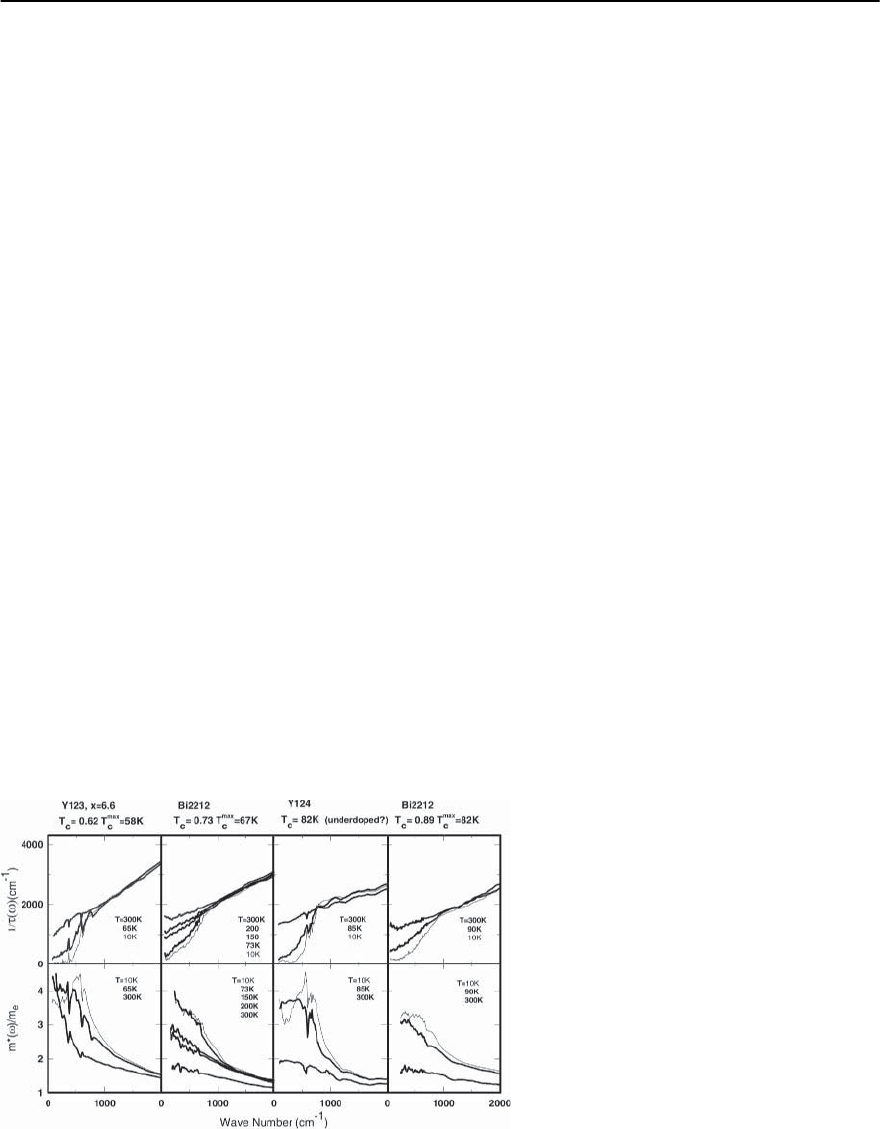
21 Concepts in High Temperature Superconductivity 1241
S(x) ≡ S(x, T)−S(x
optimal
, T), with a magnitude
which is independent of temperature for any T > T
∗
.
This is the origin of the famous (and still not under-
stood) observation of Loram and collaborators[140]
that there is a large entropy, k
B
/2, which is somehow
associated with each doped hole. Awordofwarn-
ing: except at the lowest temperatures, the electronic
specific heat is always a small fraction of the total
specific heat, and complicated empirical subtraction
procedures, for which the theoretical justification is
not always clear to us, are necessary to extract the
electronic contribution.
5) Infrared Conductivity:
There is an anomalous motion of infrared spec-
tral weight to low energies [141,142]. The pseudo-
gap is most clearly identified by plotting [142] the
frequency dependent scattering rate, defined either
as 1/
∗
(!) ≡ !
ab
(!)/
ab
(!), or as 1/(!)=
[!
2
P
/4]Re[1/ (!)] where !
P
is the plasma fre-
quency; the pseudogap is rather harder to pick out
from the in-plane conductivity,
ab
,itself.Atlarge!,
one generally sees 1/(!) ≈ A!,anditthendrops
to much smaller values, 1/ !, below a character-
istic pseudogap frequency, see Fig. 21.8. (A is gener-
ally a bit larger than 1 in underdoped materials and
roughly equal to 1 in optimally doped ones.)
While in optimally doped materials, this mani-
festation of a pseudogap is only observed at tem-
peratures less than T
c
, in underdoped materials, it
is seen to persist well above T
c
, and indeed to be
not strongly temperature dependent near T
c
.Achar-
acteristic pseudogap energy is easily identified from
thisdata,but,again,itisnotcleartoustowhatextent
it is possible to identify a clear pseudogap tempera-
ture from this data.A pseudogap can also be deduced
directly [143,144] from an analysis of
c
(!), where
it manifests itself as a suppressed response at low
frequencies, as shown in Fig. 21.9.
6) Inelastic Neutron Scattering:
There are temperature dependent changes in the dy-
namic spin structure factor as measured by inelas-
tic neutron scattering. Here, both features associated
with low energy incommensurate magnetic correla-
tions(possibly associated with stripes) [145] and the
so-called“resonant peak”are found to emerge below
a temperature which is very close to T
c
in optimally
doped materials,but which rises considerably above
T
c
in underdoped materials [146] (see Fig. 21.10).
What Does the Pseud ogap Imply for Theory?
It is generally accepted that the pseudogap, in one
way or another, reflects the collective physics associ-
ated with the growth of electronic correlations. This,
more than any other aspect of the data, has focused
attention on theories of the collective variables rep-
resenting the order parameters of various possible
broken symmetry states [20,51–54,62,77,147–158].
Among these theories, there are two rather different
Fig. 21.8. Upper panels: Frequency dependent
scattering rate for a series of underdoped
cuprate superconductors above, near and be-
low the superconducting transition tempera-
ture.Lower panels: The effective mass enhance-
ment m
∗
/m
e
=1+(!). Both are deduced
from fitting infrared conductivity data to an ex-
tended Drude model =(!
2
P
/4 )/[1/(!)−
i!(1 + (!))]. From [142]
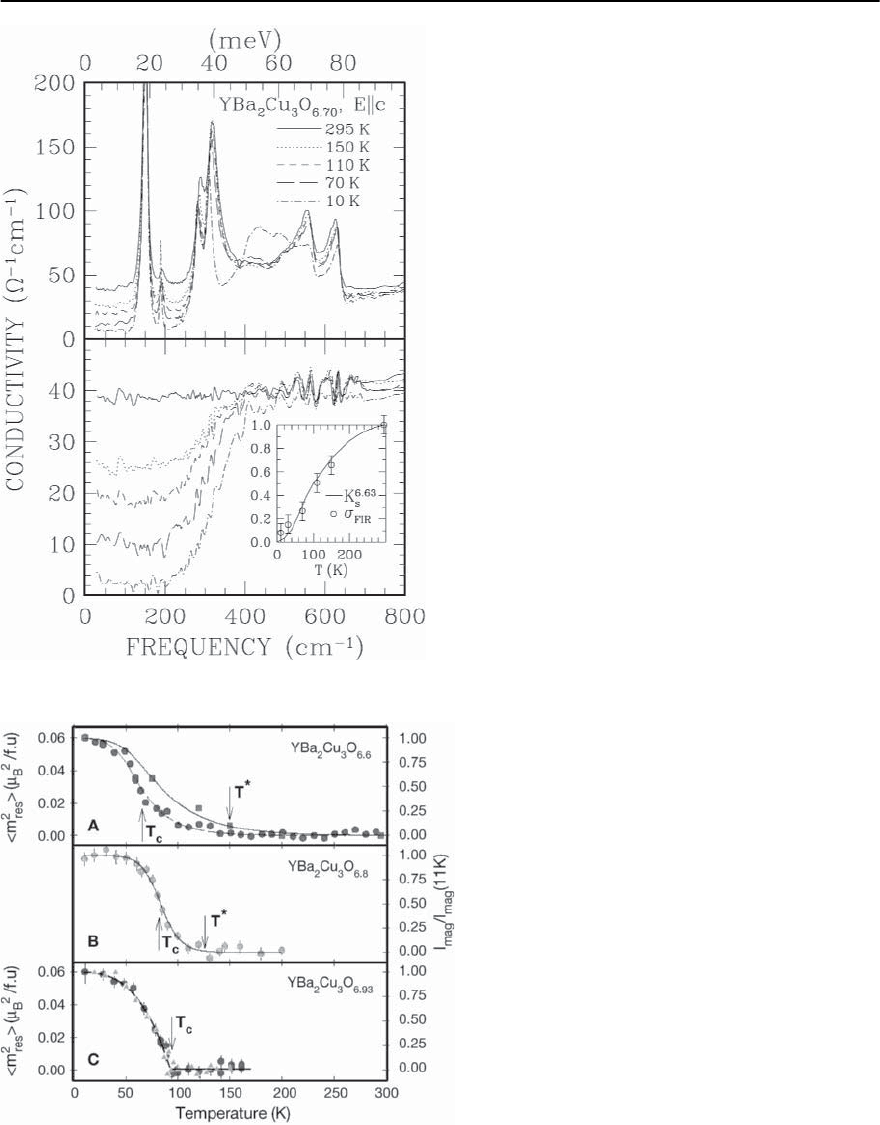
1242 E.W. Carlson et al.
Fig. 21.9. The c-axis optical conductivity of underdoped
YBa
2
Cu
3
O
7−ı
(T
c
= 63 K) as a function of temperature
(top panel).The optical conductivity after the substraction
of the phonon features is presented in the lower panel.The
inset compares the low frequency conductivity with the
Knight shift. From [143]
Fig. 21.10. The temperature dependence of the inten-
sity of the so called resonant peak observed in neutron
scattering in underdoped YBa
2
Cu
3
O
7−ı
. From [146]

21 Concepts in High Temperature Superconductivity 1243
classes of ways to interpret the pseudogap phenom-
ena.
(1)
It is well known that fluctuation effects can produce
local order which, under appropriate circumstances,
can extend well into the disordered phase. Such fluc-
tuations produce in the disordered phase some of the
local characteristicsof the orderedphase,andif there
is a gap in the ordered phase, a pseudogap as a fluc-
tuation effect is eminently reasonable—see Fig. 21.1.
As is discussed in Sect.21.8,the small superfluid den-
sity of the cuprates leads to the unavoidable conclu-
sion that superconducting fluctuations are an order
1 effect in these materials, so it is quite reasonable
to associate some pseudogap phenomena with these
fluctuations. However, as the system is progressively
underdoped,it gets closer and closer to the antiferro-
magnetic insulating state, and indeed there is fairly
direct NMR evidence of increasingly strong local an-
tiferromagnetic correlations [159]. It is thus plausi-
ble that there are significant effects of antiferromag-
netic fluctuations, and since the antiferromagnetic
state also has a gap, one might expect these fluctua-
tions to contribute to the pseudogap phenomena as
well. There are significant incommensurate charge
and spin density (stripe) fluctuations observed di-
rectly in scattering experiments on a variety of un-
derdoped materials [47,145,160–162], as well as the
occasional stripe ordered phase [163–167]. These
fluctuations,too,certainly contribute to the observed
pseudogap phenomena. Finally, fluctuations associ-
ated with more exotic phases, especially the “stag-
gered flux phase” (which we will discuss momentar-
ily) have been proposed [148,168] as contributingto
the pseudogap as well.
Crossovers can be murky.
There has been a tremendous amount of contro-
versy in the literature concerning which of these var-
ious fluctuation effects best account for the observed
pseudogap phenomena. Critical phenomena, which
are clearly associated with the phase fluctuations of
the superconducting order parameter, have been ob-
served [169–172]in regionsthat extendbetween10%
to 40% above and below the superconducting T
c
in
optimally and underdoped samples of YBa
2
Cu
3
O
7−ı
and Bi
2
Sr
2
CaCu
2
O
8+ı
;in ouropinion,the dominance
of superconducting fluctuations in this substantial
range of temperatures is now beyond question.How-
ever, pseudogap phenomena are clearly observed in
a much larger range of temperatures.Even if fluctua-
tion effects are ultimatelythe correctexplanation for
all the pseudogap phenomena,there may not truly be
one type of fluctuation which dominates the physics
over the entire range of temperatures.
One cannot always tell a fluctuating superconductor
from a fluctuating insulator!
To illustrate this point explicitly, consider a one-
dimensional electron gas (at an incommensurate
density) with weak attractive backscattering interac-
tions. (See Sect. 21.5.) If the backscattering interac-
tions are attractive (g
1
< 0), they produce a spin gap
s
. This gap persists as a pseudogap in the spectrum
up to temperatures of order
s
/2.Now,becauseof the
nature of fluctuations in one dimension, the system
can never actually order at any finite temperature.
However, there is a very real sense in which one can
view the pseudogap as an effect of superconducting
fluctuations, since at low temperatures, the super-
conducting susceptibility is proportional to
s
.The
problem is that one can equally well view the pseu-
dogap as an effect of CDW fluctuations. One could
arbitrarily declare that where the CDW susceptibil-
ity is the most divergent, the pseudogap should be
viewed as an effect of local CDW order, while when
the superconducting susceptibility is more divergent,
it is an effect of local pairing. However, this position
is untenable; by varying the strength of the forward
scattering (g
2
), it is possible to pass smoothly from
one regime to the other without changing
s
in any
way!
(2)
There are several theoretical proposals [52–54] on
the table which suggest that there is a heretoforeun-
detected electronic phase transition in underdoped
materials with a transition temperature well above
the superconducting T
c
.As a function of doping, this
transition temperature is pictured as decreasing,and
tending to zero at a quantum critical point some-

1244 E.W. Carlson et al.
Fig. 21.11. There are many ideas concerning the meaning
of the pseudogap. Defined purely phenomenologically, as
shown in Fig. 21.1, it is a region in which there is a gen-
eral reduction in the density of low energy excitations, and
hence is bounded by an ill-defined crossover line. It is also
possible that, to some extent, the pseudogap reflects the
presence of a broken symmetry, in which case it must be
bounded by a precise phase boundary, as shown in the
present figure. There are many ways such a pseudogap
phase could interact with the other well established phases.
For purposes of illustration, we have shown a tetracritical
and a bicritical point where the pseudogap meets, respec-
tively, the superconducting and antiferromagnetic phases.
One consequence of the assumption that the transition
into the pseudogap phase is continuous is the exisence of
a quantum critical point (indicated by the heavy circle)
somewhere under the superconducting dome. See, for ex-
ample,[20,52,54,62,173]
where in the neighborhood of optimal doping, as
shown schematically in Fig. 21.11.
Covert phase transitions are considered.
If such a transition occurs, it would be natural to as-
sociate at least some of the observed pseudogap phe-
nomena with it. Since these scenarios involve a new
broken symmetry, they make predictions which are,
in principle,sharply defined and falsifiable by exper-
iment. However, there is an important piece of phe-
nomenology which these theories must address: if
there is a phase transition underlying pseudogap for-
mation,why hasn’t direct thermodynamic evidence (
i.e.nonanalytic behavior of the specific heat,the sus-
ceptibility, or some other correlation function of the
system) been seen in existing experiments? Possible
answers to this question typically invoke disorder
broadening of the proposed phase transition [54],
rounding of the transition by a symmetry breaking
field [52], or possibly the intrinsic weakness of the
thermodynamic signatures of the transition under
discussion [53,174].
21.4 Preview: Our View of the Phase Diagram
Clearly, the pseudogap phenomena described above
are just the tip of the iceberg, and any understanding
of the physics of the cuprate high temperature su-
perconductors will necessarily be complicated. For
this reason, we have arranged this article to focus
primarily on high temperature superconductivity as
an abstract theoretical issue, and only really discuss
how these ideas apply to the cuprates in Sect. 21.13.
However,to orient the reader,we will take a moment
here to briefly sketchour understanding of how these
abstract issues determine the behavior,especially the
high temperature superconductivity of the cuprates.
Figure 21.12 is a schematic representation of the
temperature vs.doping phase diagram of a represen-
tative cuprate. There are four energy scales relevant
to the mechanism of superconductivity, marked as
T
∗
stripe
, T
∗
pair
, T
∗
3D
and T
c
. Away from the peak of the
superconducting dome, these energy scales are of-
ten well separated. At least some of the pseudogap
phenomena are, presumably, associated with the two
crossover scales, T
∗
pair
and T
∗
stripe
.
Stripe Formation T
∗
stripe
:
The kinetic energy of doped holes is frustrated in
an antiferromagnet. As the temperature is lowered
through T
∗
stripe
,the doped holes are effectively ejected
from the antiferromagnet to form metallic regions,
thus relieving some ofthis frustration.Being charged
objects, the holes can only phase separate on short
length scales, since the Coulomb repulsion enforces
charge homogeneity at long length scales. As a re-
sult, at T
∗
stripe
, the material develops significant one-
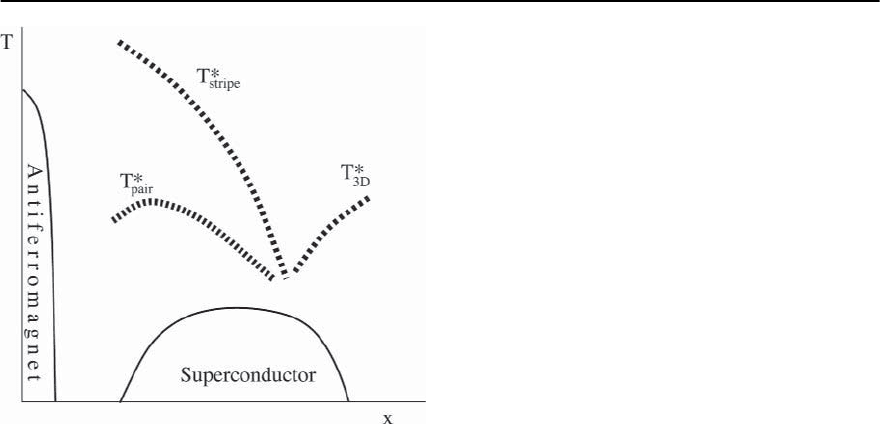
21 Concepts in High Temperature Superconductivity 1245
Fig. 21.12. Phase diagram as a function of temperature and
doping within the stripes scenario discussed here
dimensional charge modulations, which we refer to
as charge stripes. This can be an actual phase transi-
tion ( e.g. to a “nematic phase”), or a crossover scale
at which significant local charge stripe correlations
develop.
Pair Formation T
∗
pair
:
While stripe formation permits hole delocalization
in one direction, holemotion transverse to the stripe
is still restricted. It is thus favorable, under appro-
priate circumstances, for the holes to pair so that
the pairs can spread out somewhat into the antifer-
romagnetic neighborhood of the stripe. This “spin
gap proximity effect” [20] (see Sect. 21.10.4), which
is much like the proximity effect at the interface be-
tween a normal metal and a conventional supercon-
ductor,resultsin the opening of a spin gap and an en-
hancement of the superconducting susceptibility on
asinglestripe.Inother words,T
∗
pair
marks a crossover
below which the superconducting order parameter
amplitude (and therefore a superconducting pseudo
gap) has developed, but without global phase coher-
ence.
Superconductivity T
c
:
Superconducting long ranged order onsets as the
phase of the superconducting order parameter on
each charge stripe becomes correlated across the
sample. Since it is triggered by Josephson tunneling
between stripes, this is a kinetic energy driven phase
ordering transition.
Dimensional Crossover T
∗
3D
:
Superconducting long range order implies coher-
ence in all three dimensions, and hence the ex-
istence of well defined electron-like quasiparticles
[21,149, 175]. Where the stripe order is sufficiently
strong (in the underdoped regime), the dimensional
crossoverto 3D physics isdirectly associatedwith the
onset of superconducting order. However, in over-
doped materials, where the electron dynamics is less
strongly influenced by stripe formation, we expect
the dimensional crossover to occur well above T
c
.
(See Sect. 21.5.)
21.5 Quasi-1D Superconductors
In this section we address the physics of
the one-dimensional electron gas and quasi-one-
dimensional systems consisting of higher dimen-
sional arrays of weakly coupled chains. Our moti-
vation is twofold. Firstly, these systems offer a con-
crete realization of various non-Fermi liquid phe-
nomena and are amenable to controlled theoretical
treatments.As such they constitute a uniquetheoret-
ical laboratory for studying strong correlations. In
particular, for whatever reason, much of the experi-
mentally observed behavior of the cuprate supercon-
ductorsisstrongly reminiscent[84,86,149] ofaquasi-
1D superconductor. Secondly, we are motivated by a
growing body of experimental evidence for the exis-
tence of electron smectic and nematic phases in the
high temperature superconductors, manganites and
quantum Hall systems [6,176–179].It is possible that
these materials actually are quasi 1D on a local scale.
Preliminary evidence of the existence of nematic or-
der in La
2−x
Sr
x
CuO
4
and YBa
2
Cu
3
O
7−ı
can be found
in [98].
Our emphasis will be on quasi-one-dimensional
superconductors, the different unconventional sig-
natures they exhibit as a function of temperature,
and the conditions for their expression and stability.
We will, however, include some discussion of other

1246 E.W. Carlson et al.
quasi-one-dimensional phases which typically tend
to suppress superconductivity.It is also worth noting
that, for the most part, the discussion is simply gen-
eralized to quasi-1D systems with different types of
order, including quasi-1D CDW insulators.
21.5.1 Elementary Excitations of the 1DEG
We begin by considering the continuum model of an
interacting one-dimensional electron gas (1DEG). It
consists of approximating the 1DEG by a pair of lin-
early dispersing branches of left ( =−1)andright
( =1)movingspin1/2( = ±1 denotes the z
spin component) fermions constructed around the
left and right Fermi points of the 1DEG.This approx-
imation correctly describes the physics in the limit
of low energy and long wavelength where the only
important processes are those involving electrons in
the vicinity of the Fermi points. The Hamiltonian
density of the model is
H =−iv
F
,=±1
†
,
∂
x
,
+
g
4
2
,=±1
†
,
†
,−
,−
,
+ g
2
,
=±1
†
1,
†
−1,
−1,
1,
+ g
1
=±1
†
1,
†
−1,
1,
−1,
+ g
1⊥
=±1
†
1,
†
−1,−
1,−
−1,
, (21.8)
where, e.g.
1,1
destroys a right moving electron of
spin 1/2. The g
4
term describes forward scattering
events of electrons in a single branch. The g
2
term
corresponds to similar events but involving electrons
onbothbranches.Finally,theg
1
and g
1⊥
terms allow
for backscattering from one branch to the other. The
system is invariant under SU (2) spin rotations pro-
vided g
1
= g
1⊥
= g
1
. In the following we consider
mostly this case.
Umklapp processes of the form
g
3
†
−1,↑
†
−1,↓
1,↓
1,↑
e
i(4k
F
−G)x
+H.c.,
are important only when 4k
F
equals a reciprocal lat-
tice vector G. When the 1DEG is incommensurate
(4k
F
= G), the rapid phase oscillations in this term
render it irrelevant in the renormalization group
sense. We will assume such incommensurability and
correspondingly ignore this term. We will also ne-
glect single particle scattering between branches (for
example due to disorder) and terms that do not con-
serve the z component of the spin.
It is important to stress [180] that in consider-
ing this model we are focusing on the long distance
physics that can be precisely derived from an effec-
tive field theory. However, all the coupling constants
that appear in Eq. (21.8) are effective parameters
which implicitly include much of the high energy
physics. For instance, the bare velocity which enters
the model, v
F
, is not necessarily simply related to
the dispersion of the band electrons in a zeroth or-
der, noninteracting model, but instead includes all
sorts of finite renormalizations due to the interac-
tions. The weak coupling perturbative renormaliza-
tion group treatment of this model is discussed in
Sect. 21.9,below;the most important result from this
analysis is that the Fermi liquid fixed point is al-
ways unstable, so that an entirely new, nonpertur-
bative method must be employed to reveal the low
energy physics.
Bosonization
Fortunately, such a solution is possible; the Hamil-
tonian in Eq. (21.8) is equivalent to a model of
two independent bosonic fields,one representing the
charge and the other the spin degrees of freedom
in the system. (For reviews and recent perspectives
see [38, 180–186].) The two representations are re-
lated via the bosonization identity
,
=
1
√
2a
F
,
exp[−i¥
,
(x)] , (21.9)
which expresses the fermionic fields in terms of self
dual fields ¥
,
(x) obeying [¥
,
(x), ¥
,
(x
)] =
−iı
,
ı
,
sign(x − x
). They in turn are combi-
nations of the bosonic fields
c
and
s
and their con-
jugate momenta ∂
x
c
and ∂
x
s
¥
,
=
/2[(
c
−
c
)+ (
s
−
s
)] . (21.10)
Physically,
c
and
s
are, respectively, the phases of
the 2k
F
charge density wave (CDW) and spin density

21 Concepts in High Temperature Superconductivity 1247
wave (SDW) fluctuations,and
c
is thesuperconduct-
ing phase.In terms of themthe long wavelength com-
ponent of the charge and spin densities are given by
(x)=
,
†
,
,
−
2k
F
=
7
2
∂
x
c
, (21.11)
S
z
(x)=
1
2
,
†
,
,
=
7
1
2
∂
x
s
. (21.12)
The Klein factors F
,
in Eq. (21.9) are responsible
for reproducing the correct anticommutation rela-
tions between different fermionic species and a is a
short distance cutoff that is taken to zero at the end
of the calculation.
In 1D spin and charge separate.
The widely discussed separation of charge and spin
in this problem is formally a statement that the
Hamiltonian density can be expressed as a sum of
two pieces, each of the sine-Gordon variety, involv-
ing only charge or spin fields
H =
˛=c,s
v
˛
2
K
˛
(∂
x
˛
)
2
+
(∂
x
˛
)
2
K
˛
+ V
˛
cos(
√
8
˛
)
. (21.13)
When the Hamiltonian is separable, wavefunctions,
and therefore correlation functions, factor. (See
Eqs. (21.24) and (21.25).) In terms of the parameters
of the fermionic formulation Eq. (21.8) the charge
and spin velocities are given by
v
c
=
1
2
(2v
F
+ g
4
)
2
−(g
1
−2g
2
)
2
, (21.14)
v
s
=
1
2
(2v
F
− g
4
)
2
− g
2
1
, (21.15)
while the Luttinger parameters K
˛
,whichdetermine
the power law behavior of the correlation functions,
are
K
c
=
2v
F
+ g
4
−2g
2
+ g
1
2v
F
+ g
4
+2g
2
− g
1
, (21.16)
K
s
=
2v
F
− g
4
+ g
1
2v
F
− g
4
− g
1
. (21.17)
The cosine term in the spin sector of the bosonized
version of the Hamiltonian (Eq. (21.13)) originates
from the back scattering term in Eq. (21.8) where the
amplitudes are related according to
V
s
=
g
1⊥
2(a)
2
. (21.18)
The corresponding term in the charge sector de-
scribes umklapp processes and in view of our as-
sumption will be set to zero V
c
=0.Equations
(21.14)–(21.18)complete the exact mapping between
the fermionic and bosonic field theories.
In the absence of back scattering (g
1
=0)this
model is usually called the Tomonaga-Luttinger
model.Since ∂
x
c,s
and
c,s
are canonically conjugate,
it is clear from the form of the bosonized Hamilto-
nian (Eq. (21.13)) that it describes a collection of in-
dependent charge and spin density waves with linear
dispersion !
c,s
= v
c,s
k. The quadratic nature of the
theory and the coherent representation (Eq. (21.9))
of the electronic operators in terms of the bosonic
fields allow for a straightforward evaluation of vari-
ous electronic correlation functions.
For g
1
= 0 the spin sector of the theory turns into
a sine-Gordon theory whose renormalization group
flow is well known [187]. In particular, for repulsive
interactions (g
1
> 0) the backscattering amplitude is
renormalized to zero in the long wavelength low en-
ergy limit and consequently at the fixed point K
s
=1.
On the other hand,in the presence of attractive inter-
actions (g
1
< 0) the model flows to strong (negative)
coupling where the cosine term in Eq. (21.13) is rel-
evant. As a result
s
is pinned in the sense that in the
ground state, it executes only small amplitude fluc-
tuations about its classical ground state value ( i.e.
one of the minima of the cosine). There is a spin gap
to both extended phonon-like small amplitude os-
cillations about this minimum and large amplitude
soliton excitations that are domain walls at which
s
changes between two adjacent minima.
The susceptibility of the interacting one-
dimensional electron gas to various instabilities can
be investigated by calculating the correlation func-
tions of the operators that describe its possible or-
ders. They include, among others, the 2k
F
CDW and
SDW operators

1248 E.W. Carlson et al.
O
CDW
(x)=e
−i2k
F
x
†
1,
(x)
−1,
(x) , (21.19)
O
SDW
˛
(x)=e
−i2k
F
x
,
†
1,
(x)
˛
,
−1,
(x) , (21.20)
where are the Pauli matrices, the 4k
F
CDW (or
Wigner crystal) order
O
4k
F
(x)=e
−i4k
F
x
†
1,
(x)
†
1,−
(x)
×
−1,−
(x)
−1,
(x) , (21.21)
and the singlet (SS) and triplet (TS) pair annihilation
operators
O
SS
(x)=
1,
(x)
−1,−
(x) , (21.22)
O
TS
˛
(x)=
,
1,
(x)
˛
,
−1,−
(x) . (21.23)
They can also be written in a suggestive bosonized
form. For example the CDW and the singlet pairing
operators are expressed as
11
O
CDW
(x)=
e
−2ik
F
x
a
cos[
√
2
s
(x)]e
−i
√
2
c
(x)
,
(21.24)
O
SS
(x)=
1
a
cos[
√
2
s
(x)]e
−i
√
2
c
(x)
.
(21.25)
1D order parameters have “spin” amplitudes and
“charge” phases.
The distinct roles of spin and charge are vividly ap-
parent in these expressions: the amplitude of the or-
der parameters is a function of the spin fields while
their phase is determined by the charge degrees of
freedom. Similar relations are found for the SDW
and triplet pairing operators. However,the 4k
F
CDW
order is independent of the spin fields.
If in the bare Hamiltonian, g
1
> 0andV
s
is not
too large,the system flows to the Gaussian fixedpoint
with K
s
= 1 and no spin gap.The gapless fluctuations
of theamplitude(spin) and phase (charge) of thevar-
ious orders lead then to an algebraic decay of their
zero temperature space-time correlation functions
(with logarithmic corrections which reflect the slow
renormalization of marginally irrelevant operators
near the fixed point [188]):
O
†
CDW
(x)O
CDW
(0)∝e
2ik
F
x
x
−(1+K
c
)
ln
−3/2
(x) ,
O
†
SDW
˛
(x)O
SDW
˛
(0)∝e
2ik
F
x
x
−(1+K
c
)
ln
1/2
(x) ,
O
†
4k
F
(x)O
4k
F
(0)∝e
4ik
F
x
x
−4K
c
,
O
†
SS
(x)O
SS
(0)∝x
−(1+1/K
c
)
ln
−3/2
(x) ,
O
†
TS
˛
(x)O
TS
˛
(0)∝x
−(1+1/K
c
)
ln
1/2
(x) , (21.26)
where the proportionality involves model dependent
constants and where sub-leading terms have been
omitted. In the presence of interactions that break
spin rotation symmetry (g
1
= g
1⊥
)themodelflows,
for moderately repulsive bare g
1
,toapointonafixed
line with V
s
=0andK
s
> 1. Correspondingly, the
spin contribution to the decay exponent of the cor-
relation functions (see Eq. (21.26)) changes from 1
to K
s
for the CDW, SS, and the z component of the
SDW order,and from 1 to 1/K
s
forTS and the x and y
components of the SDW order. (For K
s
=1,thereare
no logarithmic correctionsand the leading behavior
is that of a pure power law [188].)
Thetemporal dependenceof theabovecorrelation
functions is easily obtained owing to the Lorentz in-
variance of the model (Eq.(21.13)).By Fourier trans-
forming them one obtains the related susceptibilities
whose low temperature behavior for the spin rota-
tionally invariant case is given according to
CDW
∝ T
K
c
−1
|ln(T)|
−3/2
,
SDW
∝ T
K
c
−1
|ln(T)|
1/2
,
4k
F
∝ T
4K
c
−2
,
SS
∝ T
1/K
c
−1
|ln(T)|
−3/2
,
TS
∝ T
1/K
c
−1
|ln(T)|
1/2
. (21.27)
Without a spin gap, SDW and triplet pairing fluctua-
tions are most relevant.
Therefore in the absence of a spin gap and for
1/3 < K
c
< 1, the 2k
F
fluctuations are the most
divergent, and the SDW is slightly more divergent
than the CDW.In the presence of strong repulsive in-
teractions when K
c
< 1/3, the 4k
F
correlations dom-
11
For a discussion of some delicate points involving Klein factors in such expressions see [183] and [185].
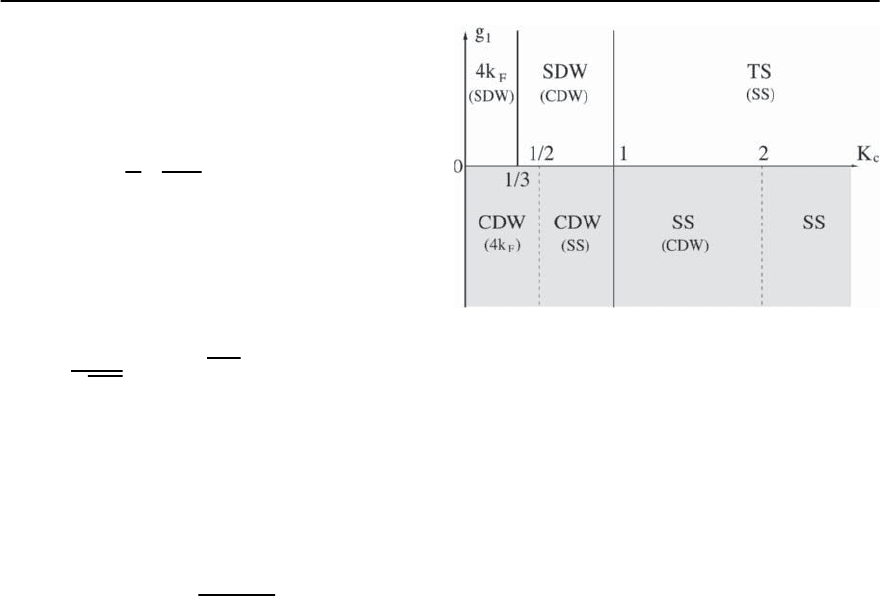
21 Concepts in High Temperature Superconductivity 1249
inate.If K
c
> 1,the pairing susceptibilities diverge at
low temperatures and triplet pairing is the dominant
channel.
When g
1
< 0, a spin gap opens of magnitude
s
∼
v
s
a
|g
1
|
2v
s
1/(2−2K
s
)
. (21.28)
This can be explicitly demonstrated at the special
Luther-Emery point [189] K
s
=1/2, where the spin
sector is equivalent to a massive free Dirac theory.
At this point, a new set of spinless fermions can be
defined
¦
≡
1
√
2a
F
exp[i
/2(
s
−2
s
)] , (21.29)
in terms of which the spin part of the Hamiltonian
can be refermionized
H
s
=−iv
s
¦
†
∂
x
¦
+
s
(¦
†
1
¦
−1
+H.c.) , (21.30)
andreadily diagonalizedto obtain the spin excitation
spectrum
E
s
=
v
2
s
k
2
+
2
s
. (21.31)
With a spin gap, CDW or singlet pairing fluctuations
are the most relevant.
In the spin gapped phase, correlations involving
spin 1 order parameters, such as SDW and triplet
pairing, decay exponentially with correlation length
s
= v
s
/
s
. On the other hand the amplitude of the
CDW and SS order parameters acquire a vacuum ex-
pectation value. Actual long range order, however,
does not occur due to the phase fluctuations associ-
ated with the still gapless charge modes. Neverthe-
less, the CDW and SS susceptibilities are enhanced
compared to the case with no spin gap and in a spin
rotationally invariant system are given by
CDW
∝
s
T
K
c
−2
,
SS
∝
s
T
1/K
c
−2
. (21.32)
As long as K
c
> 1/2 the singlet pairing suscep-
tibility is divergent but it becomes more divergent
Fig. 21.13. Phase diagram for the one-dimensional spin
rotationally invariant electron gas showing where vari-
ous zero temperature correlations diverge. Parentheses in-
dicate subdivergent correlations and the shaded region
contains the spin gapped phases. The order parameters
that appear in the figure are: singlet superconductivity
(SS); triplet superconductivity (TS); 2k
F
spin density wave
(SDW); 2k
F
charge density wave (CDW); and 4k
F
charge
density wave (4k
F
)
than the CDW susceptibility only when K
c
> 1. The
latter diverges for K
c
< 2 and is the predominant
channel provided K
c
< 1. Figure 21.13 summarizes
the situation for low temperatures showing where in
parameter space each type of correlation diverges.
Concer ning the sign of the effective interactions.
We see that the low energy behavior of a system with
a spin gap is basically determined by a single param-
eter K
c
. For a Hubbard chain with repulsive interac-
tions, it is well known [190] that K
c
< 1, but this is
not a general physical bound. For instance, numeri-
cal experiments on two leg Hubbard ladders (which
are spin gapped systems as we discuss in Sects.21.10
and 21.11) have found a power law decay r
−
of the
singlet d-wave pairing correlations along the ladder.
Figure 21.14 presents the minimal value of the decay
exponent obtained for ladders with varying ratio
of inter- to intra-leg hopping t
⊥
/t as a function of
therelativeinteractionstrengthU/t [191]. By com-
paring it with the corresponding exponent =1/K
c
calculated for a spin gapped one-dimensional sys-
tem, one can see that K
c
> 1/2 over the entire range
of parameters and that for some ranges K
c
> 1. Our
point is that in a multicomponent 1DEG,it is possible
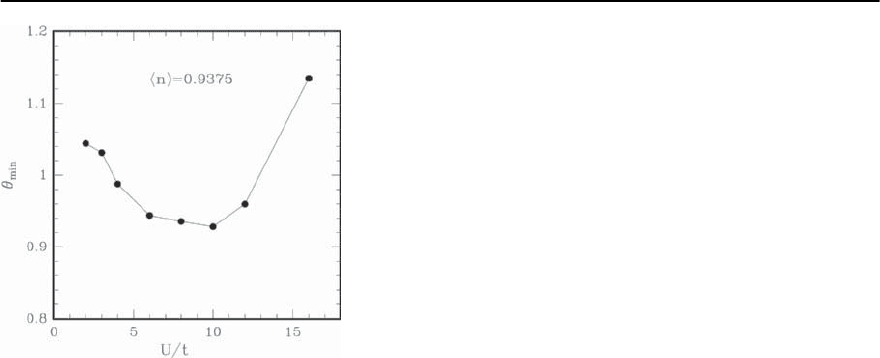
1250 E.W. Carlson et al.
Fig. 21.14. Minimal value of the decay exponent, =1/K
c
,
of the d-wave singlet pairing correlations in a two leg
ladder with varying hopping ratio t
⊥
/t as a function of
U/t. The electron filling is n =0.9375. (From Noack et
al.[191])
to have K
c
> 1 (and thussingletsuperconductivity as
the most divergent susceptibility) even for repulsive
interactions.
21.5.2 Spectral Functions of the 1DEG–Signatures of
Fractionalization
The fact that one can obtain a strong (power law)
divergence of the superconducting susceptibility
from repulsive interactions between electrons is
certainly reason enough to look to the 1DEG for
clues concerning the origins of high temperature
superconductivity—we will further pursue this in
Sects. 21.10 and 21.11, below. What we will do now
is to continue to study the 1DEG as a solved model
of a non-Fermi liquid.
In a Fermi liquid the elementary excitations have
the quantum numbers of an electron and a nonvan-
ishing overlap with the state created by the electronic
creation operator acting on the ground state.As a re-
sult the single particle spectral function, A(k, !), is
peaked at ! = (k)=v
F
(k
F
) · (k − k
F
), where (k)is
the quasiparticle dispersion relation. This peak can
be and has been [192] directly observed using an-
gle resolved photoemission spectroscopy (ARPES)
which measures the single hole piece of the spectral
function
A
<
(k, !)=
∞
−∞
dr dte
i(k·r+!t)
†
(r, t)
(0, 0) .
(21.33)
The lifetime of the quasiparticle, (k), can be de-
termined from the width of the peak in the “energy
distribution curve” (EDC) defined by considering
A
<
(k, !)atfixedk as a function of !:
1/ = ! . (21.34)
In a Fermi liquid, so long as the quasiparticle ex-
citation is well defined (i.e. the decay rate is small
compared to the binding energy) this width is re-
lated via the Fermi velocity to the peak width k
in the “momentum distribution curve” (MDC). This
curve is defined as a cross section of A
<
(k, !)taken
at constant binding energy, !.Explicitly
! = v
F
k . (21.35)
There are no stable excitations of the 1DEG with
quantum numbers of an electron.
A very different situation occurs in the theory of the
1DEG where the elementary excitations, charge and
spin density waves, do not have the quantum num-
bers of a hole. Despite the fact that the elementary
excitationsarebosons,theygiverisetoalinearinT
specific heat that is not qualitatively different from
that of a Fermi liquid. However, because of the sep-
aration of charge and spin, the creation of a hole
(or an electron) necessarily implies the creation of
two or more elementary excitations, of which one
or more carries its spin and one or more carries its
charge.Consequently,A
<
(k, !) does not have a pole
contribution, but rather consists of a multiparticle
continuum which is distributed over a wide region
in the (k, !) plane. The shape of this region is de-
termined predominantly by the kinematics. The en-
ergy and momentum of an added electron are dis-
tributed between the constituent charge and spin
pieces. In the case where both of them are gapless
[see Figs. 21.15(a) and 21.15(b)] this means
E = v
c
|k
c
| + v
s
|k
s
| ,
k = k
c
+ k
s
, (21.36)
